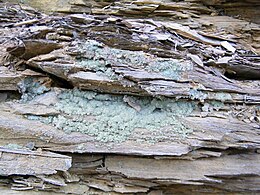Melanterite
| Melanterite | |
|---|---|
 Melanterite as found in nature | |
| General | |
| Category | Sulfate mineral |
| Formula (repeating unit) | FeSO4·7H2O |
| IMA symbol | Mln[1] |
| Strunz classification | 7.CB.35 |
| Dana classification | 29.06.10.01 |
| Crystal system | Monoclinic |
| Crystal class | Prismatic (2/m) (same H-M symbol) |
| Space group | P21/c |
| Unit cell | a = 14.077 Å, b = 6.509 Å, c = 11.054 Å; β = 105.6°; Z = 4 |
| Identification | |
| Color | Green, pale green, greenish blue, bluish green, colorless |
| Crystal habit | Encrustations and capillary efflorescences; rarely as equant pseudo-octahedral, prismatic or tabular crystals |
| Cleavage | {001} Perfect, {110} Distinct |
| Fracture | Conchoidal |
| Mohs scale hardness | 2 |
| Luster | Vitreous |
| Streak | White |
| Diaphaneity | Subtransparent to translucent |
| Specific gravity | 1.89 – 1.9 |
| Optical properties | Biaxial (+) |
| Refractive index | nα = 1.470 – 1.471 nβ = 1.477 – 1.480 nγ = 1.486 |
| References | [2][3][4][5] |
Melanterite is a mineral form of hydrous iron(II) sulfate: FeSO4·7H2O. It is the iron analogue of the copper sulfate chalcanthite. It alters to siderotil by loss of water. It is a secondary sulfate mineral which forms from the oxidation of primary sulfide minerals such as pyrite and marcasite in the near-surface environment. It often occurs as a post mine encrustation on old underground mine surfaces. It also occurs in coal and lignite seams exposed to humid air[3] and as a rare sublimate phase around volcanic fumaroles.[5] Associated minerals include pisanite, chalcanthite, epsomite, pickeringite, halotrichite and other sulfate minerals.[5]
It was first described in 1850.[5]
Gallery
- Crystal structure of melanterite
- Cuprian melanterite
References
- ^ Warr, L.N. (2021). "IMA–CNMNC approved mineral symbols". Mineralogical Magazine. 85 (3): 291–320. Bibcode:2021MinM...85..291W. doi:10.1180/mgm.2021.43. S2CID 235729616.
- ^ Mineralienatlas
- ^ a b Mindat
- ^ Webmineral data
- ^ a b c d Handbook of Mineralogy

